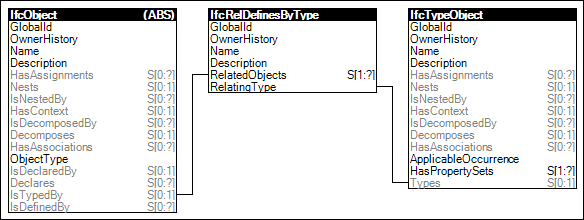
Figure 9 — Object Typing
Object Occurrences may be defined by a particular Object Type, where such type describes common characteristics. Such characteristics include common properties, shapes, materials, composition, and other concepts described at particular entities. An object occurrence may have similar state as its object type, overridden state for particular characteristics, or have no defined type object.
A pair of entities are defined for various object occurrences and object types, where such object occurrence entity may only be defined using a particular object type entity. For example, the IfcTank occurrence object entity has a corresponding IfcTankType type object entity.
Many object occurrence and object type entities have an attribute named PredefinedType consisting of a specific enumeration. Such predefined type essentially provides another level of inheritance to further differentiate objects without the need for additional entities. Predefined types are not just informational; various rules apply such as applicable property sets, part composition, and distribution ports.
For scenarios of object types having part compositions, such parts may be reflected at object occurrences having separate state. For example, a wall type may define a particular arrangement of studs, a wall occurrence may reflect the same arrangement of studs, and studs within the wall occurrence may participate in specific relationships that do not exist at the type such as being connected to an electrical junction box.
Figure 9 illustrates an instance diagram.
 |
Figure 9 — Object Typing |
This concept is used by entities for exchanges as shown.
| IfcElement | - - |
- - |
- - |
- - |
O O |
O O |
O O |
O O |
O O |
O O |
O O |
O O |
O O |
O O |
O O |
O O |
O O |
O O |
O O |
O O |
O O |
O O |
O O |
O O |
O O |
O O |
O O |
O O |